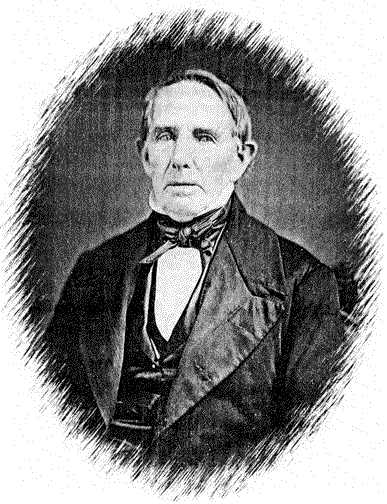Keeping Up With The Joneses A Daunting Task
Web editor's note: This article, by Sullivan County historian John Conway, is of interest to Freemasons because Samuel and then John P. Jones were the first Worshipful Masters of the first Masonic Lodge in Sullivan County -- Sullivan #272. For more information, see Benton (1947). This "Retrospect" column ran in The Sullivan County Democrat, March 12, 2004.
Brothers Samuel F. and John P. Jones were by no means the earliest settlers of the rugged and desolate area that was to become Sullivan County, but they were likely the most visionary.
The brothers, who were, in the words of historian James Eldridge Quinlan, "as much unlike as a mastiff and a sleuth-hound" arrived here in March of 1803, and between them purchased a little over 1,860 acres for about $4,600. The following year they set about building their own village, which they called Monticello, after Thomas Jefferson's own "heavenly mountain."
The Jones brothers were born in Goshen, Connecticut, and grew up in Lebanon, in Columbia County. Samuel Frisbee Jones was the older of the pair, and has been described as "an active, energetic man, of quick, decided utterance, when he did not stutter. In his early days, his mind was sound and vigorous, and his executive talent of a superior order. His intellect fathomed a project promptly, and he was at once ready to engage or avoid participating in it."
Samuel went on to become postmaster, county court judge, and Thompson supervisor. He almost single-handedly secured the designation of County Seat for his village and was arguably the most powerful and influential man in the county for a time. Unfortunately, he became intemperate, and "gave free indulgence to his appetite for spirituous liquors. He became poor and died in the prime of his life."

John P. Jones, (Quinlan and others have recorded his middle name as Paul, but it was more likely Patterson) was "of slow and hesitating speech. As a business man he was tedious and tardy, but sure to reach a safe conclusion so far as his own interests were involved. He was cautious and sagacious, slow and sure. He never engaged in any matter which he did not understand thoroughly. He saw a cause, and traced it to its logical end with infinite pains and unerring persistency."
John P. Jones built the first house in Monticello - he cut down the first tree with his own hands on September 4, 1804 - and the first store. He became postmaster, county clerk, town supervisor, state senator and a member of the Electoral College.
But the brothers had little more than their ambitions when they first arrived here. The land they purchased was so swampy and densely overgrown that they became lost and separated on their initial visit and nearly perished before they could find one another. Quinlan wrote that the place was "literally a cover for wolves and bear." Before the Joneses built their own saw-mill in 1803, sawed lumber could not be procured closer than Thompsonville, which could be reached only by way of Bridgeville and Wakeman's Ford. Despite these factors, the brothers "founded a beautiful capital for the county - a splendid monument of correct taste and far-reaching enterprise, and stamped upon it indelible characteristics which will proclaim their wisdom and worth to future generations."
The Jones brothers carefully and deliberately chose the exact location for the village they envisioned becoming the most significant in a new county. Quinlan notes that Samuel F. Jones had become involved with the affairs of the Newburgh-Cochecton Turnpike Company, which was chartered in 1801.
"In 1802, he explored the forests west of the Mamakating valley for a feasible route, and came to the conclusion that when the road was completed, a new county would be formed from the southwest territory of Ulster, and that there would be a very considerable influx of settlers to the region thus opened," Quinlan wrote. "Believing that the capital of this new county would be on the important thoroughfare from the Hudson to the Delaware, he decided that its present location was a favorable point...The route of the Turnpike Company through Thompson was not determined until the spring of 1804. The road line was run, and established precisely where Samuel F. Jones desired to have it. The brothers then located their intended village, and before there was even a log-hut in it, surveyed the streets and the 'public square,' the lines of which they marked on the forest trees. At the same time, they gave the name of Monticello to their unbuilt village."
Monticello went on to become "the garden spot of the mountains," a place known far and wide for its beauty and charm. Hamilton Child noted in his "Gazetteer and Business Directory for 1872-73" that the village possessed "a pure, healthy atmosphere and is surrounded by some of the most attractive and picturesque scenery the country affords. This village possesses unusual attractions for the tourist in search of health or recreation."
By the time Monticello was formally incorporated on April 20, 1830, it had already become a thriving mercantile center, and by 1870 had seen only one business failure in 30 years.
That village turns 200 years old this year, and although it no longer touts itself as "the garden spot of the mountains," it remains the largest and most important community in the county. A handful of stalwart residents under the direction of business man Les Kristt are hard at work organizing a bicentennial celebration for August, but enthusiasm for the project has not been contagious, and the task has become as daunting as the Jones brothers faced in constructing the village in the first place. Sullivan County folks are traditionally apathetic about their history, and the group will need the vision of Samuel F. Jones and the persistence of John P. Jones to be successful.
(c) 2004, John Conway
Posted here with permission.
